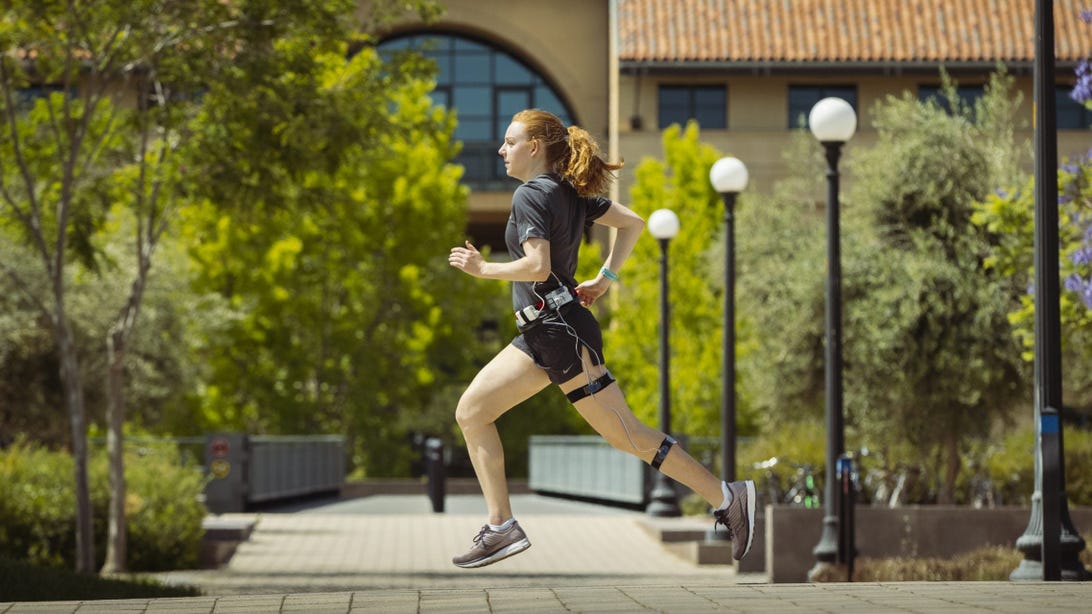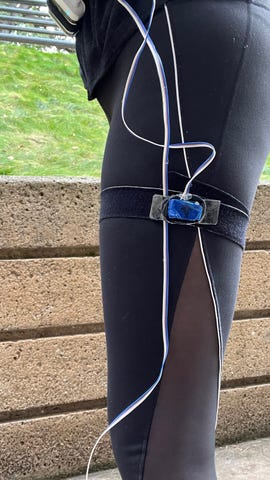The most accurate calorie burn tracker isn’t a smartwatch — and you can make one yourself
Smartwatches are great tools for keeping track of your activity. They can monitor your heart rate during a workout and track your sleep, and some even help manage workout recovery. But several studies show smartwatches and fitness trackers don’t do as good of a job at calculating calorie burn during activity and can be off anywhere between 40% to 80% of your actual energy expenditure.?
A new wearable developed at Stanford University claims to be far more accurate. It’s not worn on the wrist — you put it on your leg.
That’s because it measures leg motion, where most of your energy is used during lower body exercises like walking, running, climbing stairs and cycling. It uses two inertial measurement units (IMUs) plus a battery unit and microcontroller worn on the hip. Definitely not as convenient as strapping on a wrist-based smartwatch or tracker, but it’s the first proof of concept developed by Stanford University graduate student Patrick Slade.?
Measuring calorie burn accurately is important for a number of reasons, but mainly because it can help people manage their weight. “We want to understand the connection between physical activity and obesity so we can develop new interventions to help people live longer, healthier and more fulfilling lives,” says Steve Collins, associate professor of mechanical engineering at Stanford University, who co-authored the findings with Slade.
Naturally, I wanted to put this system to the test to see if a tracker worn on my leg could really be more accurate at estimating calories burned than one on my wrist.

Stanford graduate student Delaney Miller wearing the leg tracker.
Andrew BrodheadMeasuring calorie burn is complex
Most consumer wearables use heart rate and wrist-based motion to calculate calorie burn during activity. But heart rate isn’t directly related to the energy you are expending, says Slade. “Your heart is just pumping blood through your body and has a bunch of different factors that affect it,” he says. “How tired you are, if you had coffee, worked out, this time history makes it really volatile.”

Despite the wires, the tracker didn’t get in the way during my workouts and is lightweight.
Lexy Savvides/CNET
Instead, his system breaks down motion into each step, then uses a machine-learning model to calculate energy expenditure. It was tested with over a dozen participants of varying ages and weights and averaged 13% error, compared with 40% to 80% error from consumer wearables.
To test its accuracy for myself, I’ve come to Stanford University’s human performance lab, filled to the brim with a range of sophisticated workout equipment including an antigravity treadmill. But for the purposes of testing out this new wearable, only regular gym machines like a stair climber and exercise bike are needed. I’ll be doing four workouts for 5 minutes each: walking, running, cycling and stair stepping.
Putting on Slade’s system is straightforward. You strap two stretchy bands with the IMUs on your thigh and shin, then wrap a controller and battery around your waist. It feels like I have a small smartphone strapped to my midsection and I don’t even notice the wires running down my legs.?
I also put on a lab-grade respirometer to measure my actual energy expenditure. This monitors the carbon dioxide I breathe out and the oxygen I breathe in to give me what Slade calls the “ground truth” reading, or my actual calorie burn. It costs tens of thousands of dollars and weighs about 5 pounds complete with mask and backpack, so it’s not really the best tool for people to use outside the lab.
Finally, I strap a smartwatch to my wrist to get its calorie estimations. After my workouts, we’ll compare results from all three devices.?
Once we get a baseline reading from the respirometer, I start working out. I know I’m not going to be setting any pace records with all these tools strapped to my body, but fortunately that doesn’t matter — we’re only tracking energy expenditure.
The results are in — and they’re surprising
After gathering all the data points from each device, Slade walks me through the results. For running, the respirometry device said I burned 87 calories, the leg wearable 66 calories and the smartwatch 52 calories. You can see the rest of the calorie counts per exercise in the video on this page, but across all four workouts, the leg wearable error rate was 14% compared with 58% from the watch on my wrist. Turns out the watch was underestimating my overall calorie burn during each exercise, but Slade tells me it could overestimate for someone else. “People can’t necessarily just scale the smartwatch estimates by a fixed amount to make them accurate for everyone,” he says.
For now, this leg-based system only works for lower-body exercises, but he’s already thinking of ways to make a version that can also take into account upper-body movement like weightlifting. “Maybe using an IMU in your smartwatch to get that arm motion, if you’re doing a rep you could perhaps use the same modeling approach,” he says. The research paper also encourages smartwatch engineers to use its method to improve calorie tracking effectiveness.
You can’t buy this new wearable, but you can make it yourself. All of the instructions and code?were made available in the hopes this will help speed up development. Slade is also working on a smaller and lighter version that could be integrated into clothing and maybe even use a smartphone as the controller.
For these sorts of trackers viable, they’ll need to be affordable and small enough to wear all day, so we can track our energy expenditure on a second-by-second basis. “So you can really understand which activities led to the energy expenditure and how intense it was,” Collins tells me. The end goal? By tracking our activity more accurately, wearables will be able to give us personalized insights into how to exercise or manage our weight.